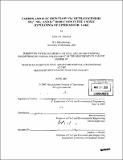Carbon and electron flow via methanogenesis, So₄²⁻, NO₃⁻ and Fe³⁺ reduction in the anoxic hypolimnia of upper Mystic Lake
Author(s)
Peterson, Eliza J. R. (Eliza Jane Reader), 1979-
DownloadFull printable version (3.480Mb)
Other Contributors
Massachusetts Institute of Technology. Dept. of Civil and Environmental Engineering.
Advisor
Harold Hemond.
Terms of use
Metadata
Show full item recordAbstract
The profiles of CH₄ and CO₂ obtained by the use of a novel sampler, along with the profiles for nitrate (NO₃⁻), sulfate (So₄³⁻)and iron (Fe²⁺) were used to estimate the rates of the various anaerobic decomposition reactions during spring and fall stratification in Upper Mystic Lake. The equivalent electron and carbon flow of the reactions were also calculated to obtain a mass balance within the hypolimnia of UML. From the calculations, the approximate organic carbon decomposition rate, measured as CO₂ accumulation, was 7.54 mmol m⁻² d⁻¹. The amount of decomposition from the reactions involving nitrate, sulfate, iron and methane formation together accounted for 80% of the total organic carbon decomposition. Therefore, 20% of the CO₂ accumulation in UML could not be accounted for. Possible explanations for the excess CO₂ production could be the formation of reduced iron minerals and/or the loss of methane due to ebullition and oxidation. Such explanations suggest future studies of UML to better resolve the electron budget. In order to study the redox balance in Upper Mystic Lake, a method was devised for precisely sampling dissolved gases in the water column. Like other stratified lakes, UML has a large amount of anaerobic metabolism of organic matter occurring in the sediments and a subsequent accumulation of methane (CH₄) and carbon dioxide (CO₂) in the hypolimnia. Previously, limnological sampling for dissolved gases involved filling glass bottles with water pumped from depth using a peristaltic pump; however, such methods introduce the potential for gas exchange with the atmosphere. Therefore, there was a need for a dissolved gas sampler that could be used to obtain samples at precise depth intervals while at the same time isolating the samples from outside influences.
Description
Thesis (S.M.)--Massachusetts Institute of Technology, Dept. of Civil and Environmental Engineering, 2005. Includes bibliographical references (leaves 94-96).
Date issued
2005Department
Massachusetts Institute of Technology. Department of Civil and Environmental EngineeringPublisher
Massachusetts Institute of Technology
Keywords
Civil and Environmental Engineering.